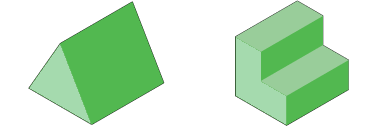
Surface Area of Prisms II

What is surface area?
As the words suggest surface area, is the area of a surface. Surface area is very useful. Here are some examples:

In construction, surface area affects planning (how much to buy) and costs (how much to charge) in connection with such things as wallboard, shingles, and paint.
In manufacturing you will have the same issues - say, the cost of making boxes or printing, or sheet metal parts.
In designing, surface area enters into calculations of wind resistance and drag in cars or airplanes, pressure and strength of materials.
The surface area exposed to air affects how fast something cools or heats or dries out. Elephants, for example, need big ears to increase their surface area for cooling purposes, so it's not only human designers that have to do these calculations.
Many objects have complex shapes to increase their surface area: the inside of your lungs, intestines, and brain, air cleaners, radiators - and towels. Others avoid flat shapes to minimize surface area and avoid drying out: pine needles and cactus for example.
Many things you buy for home use are priced by surface area - or, if not, you should figure out their cost per square metre to decide which is the best buy.
We have already been introduced to the idea of solid objects such as prisms. We saw these when we were playing with volumes (here and here). So we can recognise these sorts of shapes as being prisms.

Surface Area of Prisms
A prism has two end pieces which are congruent (exactly the same).
It also has a number of faces that join the 2 end pieces together.
For example, this triangular prism has 2 triangular end pieces and then 3 faces. We could see that this shape would have a net that looked like this.

The surface area of this shape will be the sum of the area of all the faces. This is the same as the total area of the net.
2 triangle pieces and 3 rectangular pieces
We know how to find the area of a triangle, so these pieces will be easy. The three rectangles have dimensions equal to the lengths of the sides of the triangle and width equal to the height of the prism.
Have a look at this interactive to see how to unfold prisms.
Surface Area Calculations
So when needing to calculate the surface area (SA) of a prism you need to add up the areas of individual faces. Take care not to miss faces or double up and look for clever methods too, like 2 faces that might have the same area!
$\text{Surface Area of a Prism }=\text{Sum of areas of all faces}$Surface Area of a Prism =Sum of areas of all faces
Worked Examples
QUESTION 1
What is the surface area of a cube with side length $4$4 cm?
QUESTION 2
The dimensions of a trapezoidal prism are given in the following diagram (not drawn to scale):
Find the surface area of the trapezoidal prism.
QUESTION 3
Find the surface area of the figure shown.

